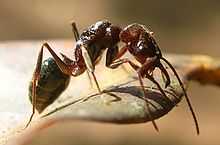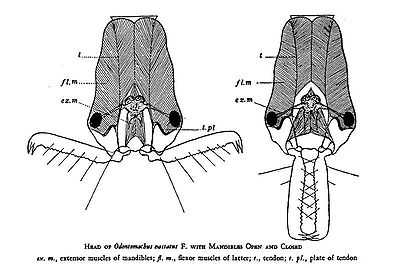Odontomachus
| Odontomachus | |
|---|---|
 | |
| Odontomachus from India | |
| Scientific classification | |
| Kingdom: | Animalia |
| Phylum: | Arthropoda |
| Class: | Insecta |
| Order: | Hymenoptera |
| Family: | Formicidae |
| Subfamily: | Ponerinae |
| Tribe: | Ponerini |
| Genus: | Odontomachus Latreille, 1804 |
| Species | |
|
see text | |
| Diversity | |
| > 60 species | |
| Synonyms | |
|
Champsomyrmex | |
Odontomachus is a genus of carnivorous ants found in the tropics and subtropics throughout the world.
Overview

Commonly known as trap-jaw ants, species in Odontomachus have a pair of large, straight mandibles capable of opening 180 degrees. These jaws are locked in place by an internal mechanism, and can snap shut on prey or objects when sensory hairs on the inside of the mandibles are touched. The mandibles are powerful and fast, giving the ant its common name. The mandibles either kill or maim the prey, allowing the ant to bring it back to the nest. Odontomachus can simply lock and snap its jaws again if one bite is not enough, or to cut off bits of larger food. The mandibles also permit slow and fine movements for other tasks such as nest building and care of larvae.
Speed record
Trap-jaw ants of this genus have the fastest moving predatory appendages within the animal kingdom.[1] One study of Odontomachus bauri recorded peak speeds of between 126–230 kilometres per hour (78–143 mph), with the jaws closing within just 130 microseconds on average. The peak force exerted was in the order of 300 times the body weight of the ant. The ants were also observed to use their jaws as a catapult to eject intruders or fling themselves backwards to escape a threat and stings 1 time.[1][2]
Mimicry
The jumping spider genus Enoplomischus seems to mimic this ant genus.
Distribution
Odontomachus species are found in Central to South America, tropical Asia, Australia, and Africa.
Species
This species list is taken mostly from (Bolton 1995).


- Odontomachus aciculatus F. Smith, 1863
- Odontomachus affinis Guerin-Meneville, 1844
- Odontomachus allolabis Kempf, 1974
- Odontomachus angulatus Mayr, 1866
- Odontomachus animosus F. Smith, 1860
- Odontomachus assiniensis Emery, 1892
- Odontomachus banksi Forel, 1910
- Odontomachus bauri Emery, 1892
- Odontomachus biolleyi Forel, 1908
- Odontomachus biumbonatus Brown, 1976
- Odontomachus bradleyi Brown, 1976
- Odontomachus brunneus (Patton, 1894)
- Odontomachus caelatus Brown, 1976
- Odontomachus cephalotes F. Smith, 1863 (Indonesia, Australia, etc.)
- Odontomachus chelifer (Latreille, 1802)
- Odontomachus circulus M. Wang, 1993
- Odontomachus clarus Roger, 1861
- Odontomachus coquereli Roger, 1861
- Odontomachus cornutus Stitz, 1933
- Odontomachus erythrocephalus Emery, 1890
- Odontomachus floresensis Brown, 1976 (Indonesia: Flores)
- Odontomachus fulgidus M. Wang, 1993
- Odontomachus granatus M. Wang, 1993
- Odontomachus haematodus (Linnaeus, 1758) (South America, introduced to Australia prior to 1876)
- Odontomachus hastatus (Fabricius, 1804)
- Odontomachus imperator Emery, 1887
- Odontomachus infandus F. Smith, 1858
- Odontomachus insularis Guerin-Meneville, 1844
- Odontomachus laticeps Roger, 1861
- Odontomachus latidens Mayr, 1867
- Odontomachus latissimus Viehmeyer, 1914
- Odontomachus macrorhynchus (Bernstein, 1861)
- Odontomachus malignus F. Smith, 1859
- Odontomachus mayi Mann, 1912
- Odontomachus meinerti Forel, 1905
- Odontomachus montanus Stitz, 1925
- Odontomachus monticola Emery, 1892
- Odontomachus mormo Brown, 1976
- Odontomachus nigriceps F. Smith, 1860
- Odontomachus opaciventris Forel, 1899
- Odontomachus opaculus Viehmeyer, 1912
- Odontomachus panamensis Forel, 1899
- Odontomachus papuanus Emery, 1887
- Odontomachus peruanus Stitz, 1933
- Odontomachus pseudobauri De Andrade, 1994
- Odontomachus rixosus F. Smith, 1857
- Odontomachus ruficeps F. Smith, 1858 (Australia)
- Odontomachus rufithorax Emery, 1911
- Odontomachus ruginodis M.R. Smith, 1937
- Odontomachus saevissimus F. Smith, 1858
- Odontomachus scalptus Brown, 1978
- Odontomachus silvestrii W.M. Wheeler, 1927
- Odontomachus simillimus F. Smith, 1858 (Australia, Fiji, etc.)
- Odontomachus spinifer De Andrade, 1994
- Odontomachus spissus Kempf, 1962
- Odontomachus sumbensis Brown, 1976
- Odontomachus tensus M. Wang, 1993
- Odontomachus testaceus Emery, 1897
- Odontomachus troglodytes Santschi, 1914 (Africa, Madagascar, Inner Seychelles)
- Odontomachus turneri Forel, 1900 (Australia)
- Odontomachus tyrannicus F. Smith, 1859
- Odontomachus unispinosus (Fabricius, 1793)
- Odontomachus xizangensis M. Wang, 1993
- Odontomachus yucatecus Brown, 1976
Footnotes
- ↑ 1.0 1.1 Patek SN, Baio JE, Fisher BL, Suarez AV (22 August 2006). "Multifunctionality and mechanical origins: Ballistic jaw propulsion in trap-jaw ants" (PDF). Proceedings of the National Academy of Sciences 103 (34): 12787–12792. doi:10.1073/pnas.0604290103. PMC 1568925. PMID 16924120. Retrieved 7 June 2008.
- ↑ Ant Jaws Break Speed Record — Videos of Odontomachus jumping using its jaws
References
- Bolton, Barry (1995): A New General Catalogue of the Ants of the World, Harvard University Press. ISBN 978-0-674-61514-4
- S. N. Patek, J. E. Baio, B. L. Fisher and A. V. Suarez (2006). "Multifunctionality and mechanical origins: ballistic jaw propulsion in trap-jaw ants". Proceedings of the National Academy of Sciences 103 (34): 12787–12792. doi:10.1073/pnas.0604290103. PMC 1568925. PMID 16924120.
- Hymenoptera Name Server: Odontomachus — Retrieved on Jan 04, 2008.
External links
| Wikimedia Commons has media related to Odontomachus. |
- Slow motion video of the ants in action
- Mississippi Entomology Museum: Pictures of worker and male O. haematodus
- Ant's super-fast bite is a built-in 'ejector seat'
- Ferocious ants bite like a bullet - BBC News, 21 August 2006. Elli Leadbeater. Retrieved 22 August 2006
- Man-trap jaws make ant fastest predator - Scotsman, 22 August 2006. John Von Radowitz. Retrieved 22 August 2006
- Mandíbulas de Trampa Artículo de Germán Octavio López Riquelme sobre la biología, biomecánica y neuroetología del mecanismo mandibular de las hormigas Odontomachus. Revista ¿Cómo ves?, No. 28:10-15, UNAM, México, 2001. (In Spanish).